Dosa is a fermented bread from the southern region of India. I eat dosa daily, and I can tell a difference in my well-being if I don’t have my daily dose of dosa. I started eating dosa after I met my wife of almost 30 years. Her parents are from northwestern India. Although she was born and raised outside of India, in a country where South Indians are more common. I am an American with ancestry from Europe and Scandinavia.
Dosa dough is normally made in a machine called a wet grinder. It can also be made in a blender, but doing so creates an inferior product for two reasons. First, a blender mixes too much air into the dough. Second, a wet grinder mashes the grain, whereas a blender cuts the grain with its blades, resulting in a less fibrous dough. A wet grinder has round granite roller stones that rotate in a pan with a granite stone bottom and a stainless steel side, and the grain is mashed between the heavy stones and the bottom of the pan.
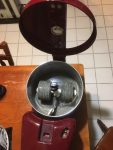 We have two Astra wet grinders, one with two granite stones and one with three. My wife’s sister in India bought them for us many years ago. She ordered the first one with three stones and a 110-volt motor since we were going to be using it in the U.S. It worked fine for a short time until one day when I was using it, it started spewing heavy black smoke out of the motor. I shut it off, pulled the plug, and ran outside with it before it burned the house down. It burned the countertop, leaving a big black spot where the grinder had been setting. I took it apart and discovered that the motor was actually a 220-volt motor, but a second starting capacitor had been put on that it so it would start on 110 volts. This made the motor run hot until it eventually burned up.
We have two Astra wet grinders, one with two granite stones and one with three. My wife’s sister in India bought them for us many years ago. She ordered the first one with three stones and a 110-volt motor since we were going to be using it in the U.S. It worked fine for a short time until one day when I was using it, it started spewing heavy black smoke out of the motor. I shut it off, pulled the plug, and ran outside with it before it burned the house down. It burned the countertop, leaving a big black spot where the grinder had been setting. I took it apart and discovered that the motor was actually a 220-volt motor, but a second starting capacitor had been put on that it so it would start on 110 volts. This made the motor run hot until it eventually burned up.
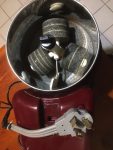 My sister-in-law bought us a second one, identical to the first, except that it has two stones instead of three, and it has the standard 220-volt motor. Since it came with the British style plug used in India I had to cut it off and replace it with an American plug, available from Home Depot, commonly used on 220-volt electric clothes dryers. It runs just fine on 60 Hz American power, although electrical power in India is 50 Hz.
My sister-in-law bought us a second one, identical to the first, except that it has two stones instead of three, and it has the standard 220-volt motor. Since it came with the British style plug used in India I had to cut it off and replace it with an American plug, available from Home Depot, commonly used on 220-volt electric clothes dryers. It runs just fine on 60 Hz American power, although electrical power in India is 50 Hz.
I eventually replaced the burned-up motor in the first grinder with an A.O. Smith pump motor I bought from Grainger Industrial Supply. There are three windings in the motor, and I wired it for the slowest speed so that the pan spins the same speed as the original motor. On the Astra grinders the motor spins the pan, and the granite stones turn with the rotating pan, but the frame that the granite stones are mounted on stays stationary.
The three-stone model probably grinds the dough faster, but I haven’t been able to tell much difference between the two. The advantage of the two stone grinder is that there is more room in the pan to put the soaked grains. The stones in the three stone grinder take up a lot of space in the pan, limiting the amount of dough you can grind in each batch.
Making The Dough
Traditional dosa is made from three ingredients: rice, urad dahl beans, and methi (fenugreek) seeds. The ratio is:
- 3 parts rice by volume
- 2 parts urad dahl by volume
- And a comparatively small amount of methi seeds
Some Indian grocery stores sell dosa dough, but it is made from white rice. I make my dosa with brown rice because I prefer the taste, and I think it is nutritionally better.
Urad dahl is a white bean that is sold in Indian grocery stores as either urad dahl, where the beans are split, or as urad gota, where the beans are whole. I usually buy urad gota if available, because whole beans will generally keep longer than split beans.
I like the somewhat nutty taste of methi seeds, so I use the following recipe.
- 1 2-pound bag of brown rice (approximately 4 cups)
- 3 cups of urad dahl
- 1 cup of methi seeds
Using Other Grains
I have also experimented adding a few other grains. Several years ago I found a couple steel gallon cans full of rye that my dad nitrogen packed in 1975. I added a cup of this rye to the above recipe and found that the result tasted very good. The long rye fibers are visible in the dough. I have also added a cup of barley, with not much noticeable difference in flavor.
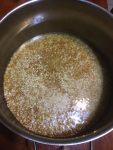 My experiments using other beans haven’t been so successful. I once tried reducing the amount of urad dahl (which are small beans), compensating with some navy beans (they were less expensive than urad dahl).
My experiments using other beans haven’t been so successful. I once tried reducing the amount of urad dahl (which are small beans), compensating with some navy beans (they were less expensive than urad dahl).
It was a disaster. When I poured the soaked grains into the wet grinder the navy beans were so large that the granite stones couldn’t roll over them and crush them. Instead, the granite stones stopped rolling and skidded along the bottom of the pan, pushing the navy beans. I think the navy beans would have worked if I had first ground the soaked beans up into smaller pieces before putting them in the wet grinder (by running them through a Champion juicer using the solid bottom plate). I think that a certain amount of urad dahl is
necessary to provide the natural bacteria and/or yeast that makes the dough ferment and rise (the details and science of which is beyond the scope of this article).
Fermentation Basics
Measure out the grains in the proper proportion into a pan that will hold at least as much as three times the volume of the dry grains. The grains expand a lot when they absorb water.
Next add un-chlorinated and un-fluoridated water (remember, dosa is a fermented dough) so that it at least covers the grains. As the grains absorb water you will need to add more water. When the grains no longer absorb water you want the water level to be just above the grains.
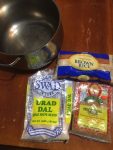 After the grains have soaked in water from 8 to 12 hours (depending on temperature) they are soft enough to grind in the wet grinder. If something happens and the grains can’t be ground the same day they are soaked, they can be stored in the refrigerator overnight and ground the next day (I have done this several times). If the grains are soaked at room temperature too long, the water that covers the grains will start to foam and smell sour. Some people like sour dosa, but I don’t.
After the grains have soaked in water from 8 to 12 hours (depending on temperature) they are soft enough to grind in the wet grinder. If something happens and the grains can’t be ground the same day they are soaked, they can be stored in the refrigerator overnight and ground the next day (I have done this several times). If the grains are soaked at room temperature too long, the water that covers the grains will start to foam and smell sour. Some people like sour dosa, but I don’t.
Grinding The Grain
In addition to the wet grinder and the pan full of soaked grains, I use the following utensils to make dosa dough.
- 2-cup measuring cup
- long-handled ladle
- rubber scraper
- turkey baster
- very large raising pan containing the ground dough
Follow the steps below:
1. Fill the 2-cup measuring cup with water.
2. Pour a cup of the water into the wet grinder pan.
3. Start the motor on the wet grinder.
4. Scoop enough soaked grains into the wet grinder to make a batch.
It is possible to get too few grains in the grinder (the dough won’t grind and flow properly) or too many grains
(the dough will be thrown over the sides of the pan outside of the grinder, making a big mess).
There is a plastic scraper mounted on an arm that faces toward the motor side of the grinder that scrapes the inside wall of the pan and keeps grains and dough from sticking to the side of the pan. If the pan is too full, this scraper will cause grains and dough to be thrown outside of the grinder pan.
5. More water will need to be added to the grains, probably even before enough of the grains have been added to make a batch.
The motor will appear to pull very hard, and the dough is very thick. Add enough water so the motor doesn’t seem to struggle. If there isn’t enough water, the dough won’t pour properly and the dosa will be too thick to cook properly. If there is too much water, the dough will run in the pan when it is cooked, making a pancake that is too large and thin to be turned easily.
6. As the grains are mashed, some of them will stick to the plastic scraper, to the steel shaft that the granite stones are mounted on, to the roller stone retaining caps, or to other stationary parts of the roller assembly. Use the turkey baster to spray water on these wayward grains to move them into the dough mixture.
7. When the dough is almost ready the granite stones will start to make a distinctive rattling sound on the granite base of the pan and the dough will no longer have lumps in it as it flows over the side scraper and the granite stones.
8. Turn off the motor and remove the pan from the grinder.
9. Using the rubber scraper, pour the dough into the very large raising pan (I use a stainless steel pan from a turkey fryer).
10. Continue with step 1 and make the next batch. If this is the last batch continue with step 11 to clean up.
11. Pour a cup of water into the empty pan and turn the motor on for a few seconds.
12. Remove the granite stone assembly from the grinder and clean them off into the grinding pan.
13. Wash off the granite stone assembly in the kitchen sink and let it dry. Do this right away, because any dried residual dough is hard to remove.
14. Remove the grinding pan from the grinder and use the rubber scraper to clean the pan, putting the contents into the raising pan containing the ground dough.
15. Wash the grinding pan in the kitchen sink and invert it to let it dry.
16. Mix the ground dough in the raising pan (mix the watery dough from cleaning the grinding pan with the rest of the dough), and then cover the raising pan with a lid.
Fermenting The Dough
I used to add salt to the dough just before starting fermentation, but I don’t do that anymore. Instead, I add salt after cooking the dosa, depending on what I’m eating the dosa with. It’s easy to add more salt if you need it. It is not so easy removing it if there’s too much.
Depending on temperature, it will usually take 12 to 24 hours for the dough to rise. It will bubble and rise as it ferments to a volume three or four times the original. When this happens use the long-handled ladle to stir the dough until it returns to its original volume.
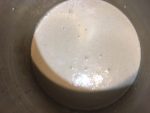 Pour the dough into containers. We usually put one container in the refrigerator (the one we’re using) and the
Pour the dough into containers. We usually put one container in the refrigerator (the one we’re using) and the
others in the freezer. Do not fill the containers completely full or they will overflow, creating a big mess, because the dough is still fermenting and raising.
Making The Dosa
I make dosa in a cast iron skillet using medium-low heat.
1. Melt a tablespoon or two of coconut oil in the skillet. Olive oil can also be used, but dosa tastes better with coconut oil.
2. Mix the dough with a spoon and pour enough into the pan to make the equivalent of a medium-sized pancake.
3. Cover the skillet with a lid. When the dough cooks to the point that it no longer looks wet on top it is ready to turn.
4. Turn the dosa with a pancake turner and turn off the heat.
5. Let the dosa cook for a few minutes with the heat off, and then remove it from the skillet.
6. Alternatively, when you turn over the dosa leave the heat on and add previously cooked meat and vegetables around the dosa to warm up while the dosa finishes cooking on the other side.
7. When the gravy starts to bubble a little turn off the heat and let it set for a few minutes until everything is properly warmed up.
Dosa is very versatile; it can be eaten as a simple vegetarian dish with dahl or coconut chutney, or with meat such as chicken curry or mutton curry.
Obtaining A Wet Grinder
My situation is somewhat unique because of my wife’s heritage and family, but wet grinders are available from amazon.com and other sources as well. They are neither cheap nor common in the U.S., but I think that they provide the best and healthiest way to prepare grains for human consumption.
Judging by the amount of energy it takes to make dosa dough, it must have been very arduous grinding it in pre-modern times by hand using stones. The Essenes must have used a similar method to grind sprouted grains by hand to make what we call Essene bread today. Online recipes providing instructions to make Essene bread using a food processor are missing the point of preserving the structure of the fibers by crushing the grain between stones.
That said, Essene bread dough could not be made with a wet grinder because the dough is much thicker and not liquid enough.
I plan to experiment further adding alternative grains such as wheat, millet, and buckwheat, as a way to use the grains I have stored for future needs.

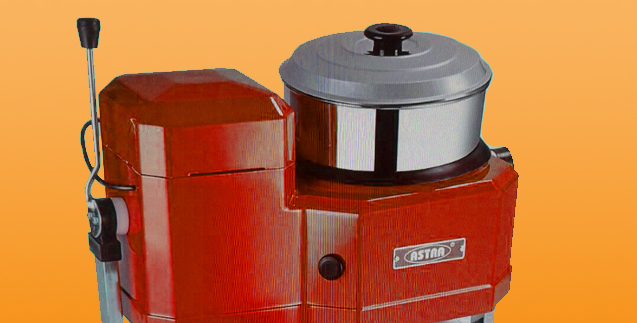









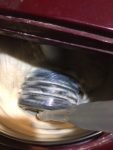
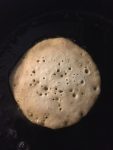
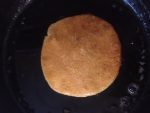
Interesting, I’ve never heard of this bread thanks for writing.
When I lived in India vendors would deliver it to the house on a daily basis. In the states it is almost impossible to find unless you have a family connection or live in a large city with an Indian community. Glad to hear you have conquered the recipe, as it is not as easy as you make in sound.
The best dosa I’ve ever had was an onion dosa made by a chef who was born, raised, and trained in India. It was divine.
Rava Dosa. It’s excellent when done well.
Interesting although I suspect any ferment benefit is lost when you bake the loaf.
I suspect the mixture of beans, grain and fenugreek is the basis of the health benefit.
I make kimchee in 5 gallon pails and it is my go to when I am feeling under the weather. When I have the “I Wanna DIE Flu” I make hot kimchee soup, essentially a bone broth chicken carcass soup with the raw kimchee added just before serving as not to kill off the ferments.
I should perhaps just eat it daily 🙂
“Let food be thy medicine and medicine be thy food.”
― Hippocrates
The best dosas I have had from the best Indian chefs have been cooked on the outside but minimally cooked on the inside, hopefully preserving at least some of the benefits of fermentation.
The mixture of beans and grain is a complete protein, and fenugreek definitely has some health benefits.
I have made kimchi but my favorite is German style sauerkraut made with cabbage and caraway seeds.
What a fascinating recipe and process! Thank you so much for taking the time to share this with all of us. I probably won’t be purchasing a wet grinder, but I’ll be searching for other ways to make this bread without losing the nutritional benefits of it. There may not be an alternative method, but I am very interested!
If you don’t have a wet grinder you will need a heavy duty blender, one with a motor that can grind the dough long enough to finish it without burning up, and with the capacity to hold enough dough to not have to make too many batches. Most blenders are designed to grind up stuff quickly, and the motors don’t have the required duty cycle to make dosa dough.
Thank you, EP!
What a fun and unique contribution to the conversation about healthful cooking! We don’t yet have a wet grinder, but will look into this, and hope to try our hands at making this delicious bread one day soon!
It takes a bit of work to make dosa, but I think the result is well worth the effort. When I grind the dough I make enough to last about 3 weeks, so it’s not something you have to do very often.
Excellent tips, EP! I also very much appreciated the discussion of which kind of grinder is best for the process. The right kitchen tools — in addition to good technique — can make a tremendous difference in success of the outcome!
Pretty neat! Thanks for sharing. It sounds really healthy and tasty.
I love dosa. My favorite is dosa with my wife’s chicken curry.
Hi E.P., very interesting article. Now we just need your naan recipe and we’ll be good to go. 🙂
I’m anxious to try this and have a couple of questions. You mentioned using old rye but do old hard beans work with this as well?
Since I probably won’t be buying a wet grinder anytime soon, I’d like to try this just grinding the beans in a regular grinder (or blender?) You mentioned the fibers get destroyed that way but are the fibers more about texture or do they affect the flavor as well?
I have some recipes that use flour tortillas but I’ve never been a big fan of flour tortillas and it sounds like dosa could replace tortillas in some recipes?
You also mentioned coconut chutney, that really sounds good too.
Thanks again for the article.
Sorry I don’t have a naan recipe for you. Naan is totally different than dosa, being made from non-fermented dough made with wheat flour. The best naan is baked in a tandoor oven.
I think you would have the same problems using old hard beans (depending on the size of the beans) that I did with navy beans. You have to be careful with the ratio of 3 parts grains to 2 parts beans. If you use more beans than grains in the dough you will have problems with it. It will probably want to stick to the pan when you cook it, and it will not hold together when you try to turn the dosa.
You can certainly use a blender to make dosa dough. My wife did this for a while until we got our first wet grinder. The dough should taste the same but it will be more soupy because the fibers are shorter and it is harder to monitor the correct amount of water to use when making the dough in a blender. You need a heavy duty blender to make dosa dough (like a Vita-Mix).
I don’t think using dosa to replace a tortilla would work very well, because a dosa is much more fragile. Naan or chappati would be a more suitable substitute.
Coconut chutney, made by an Indian chef, is very good, especially with dosa.
Hi E.P. thanks for the tips.
I love Dosa. One of my favorite foods. Thanks. We have lots of Indian markets here. Now I have to find room for grinders.
I toy with various sourdough starters, so will add this to my “to try” list. I found a whet grinder on Amazon, oof! $220 bucks. Might try a batch in my food processor first. Thanks!
Thanks for the information; these are a great addition to options for bread from storable foods. I do have one very serious concern: the key part of this for any survival-themed blog would seem to be how to make this efficiently in a grid-down situation. A couple of readers have already gently admitted that importing a 220-volt electrical appliance from India and retrofitting it to run on 110-volt AC isn’t in their future. I’d go further: while I appreciate the info and recipe, and have homemade these myself with an electric blender, I’ve long wondered how to translate this into efficient production without electric appliances. I have to think that this method, like my blender method, wouldn’t be much better as an emergency strategy than relying on Amazon to deliver food by drone after a disaster. Again, not to knock the good advice, but I have to wonder: there has to be a way people made these things all the time, efficiently enough for it to be a staple in impoverished communities, with no electric appliances. What is that way, I wonder.
As for the benefits of fermentation, there is one which might apply regardless of the heat of subsequent cooking. Some kinds of beans (kidney and tepary, for example) have substances that block protein absorption, and can even lead to protein deficiency by blocking protein absorption even from other foods. Cooking can inactivate these substances, I have read. I’ve heard some theorizing that fermentation might accomplish the same thing. I don’t know, but think it might be a theory worth following up. Thanks for the info!